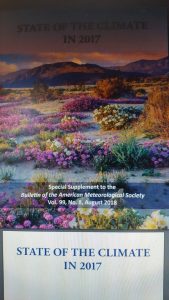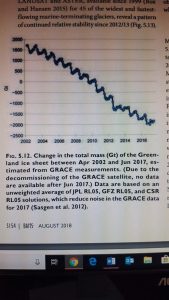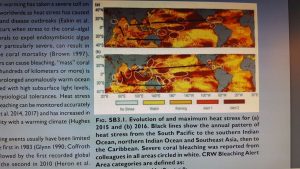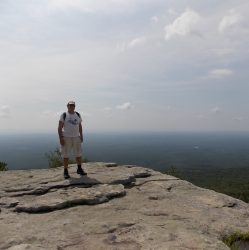2018 was the hottest year on record for Earth’s oceans.
At no time has there been more indisputable evidence that climate change must be reversed. Documented results from human production of carbon dioxide that coincides with the invention of the internal combustion engine is a reality, whether you think so or not. I have invested 6 hours of my life to select thirteen key points for you to read right after his next paragraph. Don’t run away, and don’t be afraid. It’s won’t take you more than three minutes to read this, if you are not distracted.

These 330 pages continue to speak the inconvenient truth that we must eliminate atmospheric carbon now. There is no time to wait. As you know an ocean liner or loaded freight train takes a long time to stop, and even longer to change direction.
As one person all I want tell more people about The one simple action that needs to be taken by every individual to save Earth: Elect representatives that will legislate the elimination of atmospheric carbon. Join #earthlobbyist.com
You buying an electric car, installing solar panels, or using a cloth bag will not solve the problem, and does not mean you have done your share. One round-trip flight from New York to Europe or to San Francisco on a Boeing 767-300 seating 250 creates a warming effect equivalent to 2 or 3 tons of carbon dioxide per person or 625 tons (1,250,000 pounds). The average USA citizen generates about 19 tons of carbon dioxide a year; the average European, 10.
(1) An ozone hole is small in the beginning of it’s existence. The existence is the problem, not the size. Throughout nearly the entire Southern Hemisphere, the annual mean total column ozone levels in 2017 were above the mean from the 1998–2008 reference period resulting in below-average polar ozone losses and a rather small ozone hole in size and depth (see Section 6h).
(2)- In 2017, the dominant greenhouse gases released into Earth’s atmosphere—carbon dioxide, methane, and nitrous oxide— reached new record highs.
(3) Above Earth’s surface, the annual lower tropospheric temperature was either second or third highest according to all datasets analyzed.
(4) Depending on the dataset considered, the past year temperature ranked as the second or third highest since records began in the mid-to-late 1800s at 0.38°–0.48°C above the 1981–2010 average. You now see we have used 30% of the critical 1.5C threshold.
(5)- In the Arctic, the 2017 land surface temperature was 1.6°Cabove the 1981–2010 average, the second highest since the record began in 1900, behind only 2016.
(6)- Preliminary data indicate that glaciers across the world lost mass for the 38th consecutive year on record; Cumulatively since 1980, glacier is equivalent to slicing 22 meters off the top of the average glacier. The ongoing global glacier retreat affects human society by raising sea levels, changing seasonal stream runoff, and increasing geohazards.

(7) Stronger-than-usual fire activity occurred in North America and Europe, with anomalies of +36% and +22%, respectively. The time series for North America (Fig. 2.68) shows that four out of the last five fire seasons were exceptionally intense.
(8) The long-term trend of rising permafrost temperatures worldwide continued in 2017.
(9) As Earth’s surface and the lower atmosphere warm, the total column water vapor (TCWV) is expected to increase under the assumption of near constant relative humidity, and in turn amplify the initial warming through positive water vapor feedback.
(10) Annual mean surface air temperatures during (January–December) 2017 were above normal across most of Asia and much above normal (anomalies >1.5°C) in Siberia.
(11) Continued ocean warming has taken a severe toll on tropical coral reefs worldwide as heat stress has caused repeated bleaching and disease outbreaks (Eakin et al. 2009). Heat stress causing mass coral bleaching can be monitored accurately by satellites (G. Liu et al. 2014, 2017) and has increased in frequency and severity with a warming climate (Hugheset al. 2018).

(12) At +1.6°C, the mean annual 2017 surface air temperature (SAT) anomaly for land stations north of 60°N is the second highest value (after 2016) in the record starting in 1900 (Fig. 5.1)
(13) The Arctic Ocean is experiencing changes in ocean surface temperature and sea ice extent that are unprecedented in the era of satellite observations, which extend from the 1980s to the present (see Sections 5c,d).

(14) There were 16 weather and climate events with losses exceeding $1 billion (USD) each across the United States (Fig. 7.5) in 2017, including cyclones, severe storms, inland floods, a crop freeze, drought, and wildfires. The 2017 total tied with 2011 as highest annual number of U.S.billion-dollar disasters (adjusted for inflation) since records began in 1980. Cumulatively, these events led to 362 fatalities and caused $306 billion U.S. dollars in total, direct costs—a new U.S. annual cost record.

In closing, these facts continue to speak the inconvenient truth that we must eliminate atmospheric carbon now. There is no time to wait, as you know an ocean liner or loaded freight rain takes a long time to stop, and even longer to change direction. 2018 was the hottest year on record for Earth’s oceans.
The one simple action that needs to be taken by every USA individuals to save Earth: Elect representatives that will legislate the elimination of atmospheric carbon. You buying an electric car, installing solar panels, or using a cloth bag will not solve the problem, and does not mean you have done your share. One round-trip flight from New York to Europe or to San Francisco on a Boeing 767-300 seating 250 creates a warming effect equivalent to 2 or 3 tons of carbon dioxide per person or 625 tons (1,250,000 pounds). The average USA citizen generates about 19 tons of carbon dioxide a year; the average European, 10. Now is the time to become an #earthlobbyist.com so you can tell your children and grandchildren you cared about the world where they will live and raise their families. Join #earthlobbyist.com. Sincerely, David Carr. Composed on Jan 17-18, 2019

